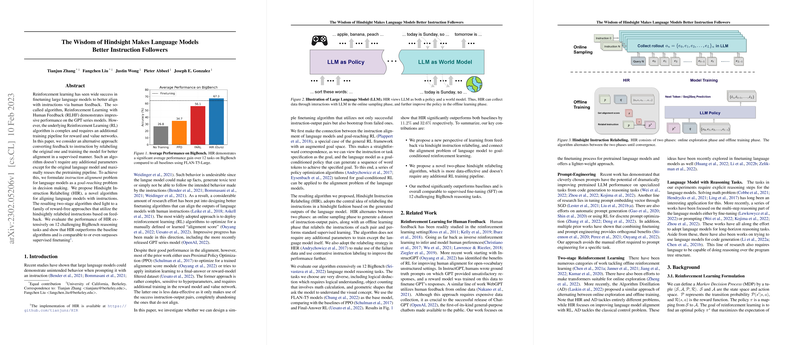The Implications of Hindsight Instruction Relabeling for LLMs
The paper titled "The Wisdom of Hindsight Makes LLMs Better Instruction Followers" presents a novel algorithmic approach to improve instruction alignment in LLMs. This paper introduces Hindsight Instruction Relabeling (HIR), a method that leverages goal-conditioned reinforcement learning (RL) techniques to refine LLM behavior without relying on traditional reinforcement learning constructs such as reward and value networks.
Key Contributions and Methodology
The authors address a critical problem in the deployment and utilization of LLMs: their occasional inability to align with human instructions, potentially leading to output that is incongruent with user expectations. Traditionally, approaches such as Reinforcement Learning with Human Feedback (RLHF) have been employed to address this issue, albeit with significant complexity due to the additional training requirements for reward networks.
HIR reframes the problem of instruction alignment as a goal-reaching task within the RL framework. By treating instructions as dynamic goals and employing a process similar to Hindsight Experience Replay (HER), HIR facilitates the relabeling of instructions based on generated outputs. This removes the necessity for additional network parameters beyond the LLM itself and maximizes pre-trained model utility.
The HIR algorithm operates in two distinct phases:
- Online Sampling Phase: Here, LLM interactions are used to generate datasets of instruction-output pairs, with varying levels of alignment quality.
- Offline Learning Phase: In this phase, instructions are "hindsight-relabeled" to align with outputs, forming a supervised learning problem that the LLM optimizes over.
This two-stage approach is contrasted with existing RL techniques that either require extensive parameter tuning (as in Proximal Policy Optimization) or are limited by inefficient data utilization (such as methods ignoring non-aligned outputs altogether).
Experimental Validation
The paper conducts extensive benchmarking on 12 tasks from the BigBench dataset, using FLAN-T5 models as the baseline. HIR exhibits notable performance improvements over strong baselines such as PPO and Final-Answer RL, surpassing them by 11.2% and 32.6% respectively. These results are significant across varied tasks, ranging from logical reasoning to computationally intensive problems such as object counting and date understanding.
Interestingly, HIR's robustness to the model size was verified by evaluating performance across different configurations of FLAN-T5. This experiment revealed consistent performance boosts, demonstrating the scalability of the HIR approach without the reliance on model-specific tuning.
Theoretical and Practical Implications
The theoretical contribution of HIR lies in its integration of RL concepts within a supervised learning paradigm, achieved through its novel relabeling strategy. By eschewing traditional RL components such as view value networks or alignment rewards, HIR simplifies the model training pipeline and demonstrates an effective alternative for instruction alignment.
Practically, HIR opens avenues for improved and more efficient deployment of LLMs in systems where human-like adaptability to vague or evolving instructions is vital. It emphasizes leveraging existing data more effectively rather than necessitating additional resources for reward modeling, which could lower barriers to implementing advanced AI in practical applications.
Future Directions
While HIR provides a compelling alternative to current RL-based fine-tuning methods, several areas offer opportunities for future research. Expansion into real-time applications of HIR could explore how real-world interactions dynamically influence instruction relabeling. Additionally, investigating the applicability of HIR to other model architectures and domains would further reinforce its generalizability and adaptability.
In conclusion, the proposal of Hindsight Instruction Relabeling presents an efficient pathway to improving LLMs' ability to align with human instructions. Its novel application of RL constructs to a traditionally supervised problem marks a meaningful stride in LLM capabilities, potentially transforming how we further explore the integration of AI into instruction-intensive tasks.
